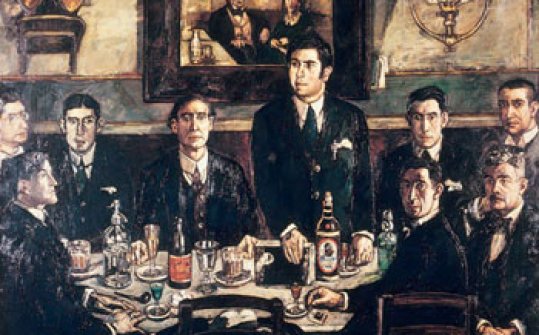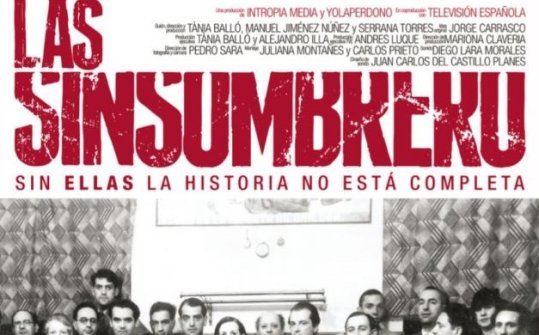The original exhibition with more than 300 objects among books, documents, paintings, posters, etc. has been converted into a graphic version that will travel to other venues.
The exhibition is structured into six main sections:
Europe in 1914
Spain’s incorporation into the modern movement began with the self-criticism carried out by the Generation of ’98 and regenerationist literature, which were intellectually and culturally part of the broader, deeper and further-reaching fin-de-siècle crisis that affected the whole of Europe. Together with a few works representing northern Europe, which had great influence on Spanish intellectuals (Schopenhauer, Nietzsche, Rilke, Mahler, Munch), the Mediterranean and its light inspired an aesthetic that symbolised the new cultural environment emanating from the southern European scene. Modernist Barcelona, Paris the ‘city of feasting’ (Apollinaire, Picasso, Sartre, Modigliani) and Rome, vibrant with the energy of futurism (Marinetti), were melting pots of a good many of the new ideas and trends that were then beginning to inundate Europe and its avant-garde movements.
A Generation for History
The Generation of ’14 made its first appearance in Spanish public life in connection with the crackdown on anarchism known as the proceso de Montjuic . Its establishment is usually dated to the months between the tribute paid to Azorín in Aranjuez on 29 October 1913 and the formation and launch of the Liga de Educación Política at its first and only event held in relation to ‘Old and New Politics’, a lecture with far-reaching repercussions delivered by José Ortega y Gasset at the Teatro de la Comedia in Madrid on 28 March 1914. Ortega y Gasset (1883-1955) enjoyed overwhelming leadership of Spain of his day from a very early age. In 1914, in addition to establishing the ideology of his own generation in ‘Old and New Politics’, he published Meditaciones del Quijote (published in English as Meditations on Quixote), an essential work that is relevant to his entire rational-vitalist philosophy. Around the same time Juan Ramón Jiménez published Platero y yo (Platero and I), the culminating poetic and aesthetic work in Spanish.
Science as a National Concern
Science was the key word for the Generation of ’14 as the driving force behind Spain’s Europeanisation with science playing an essential role in the country’s social, cultural and political life. This is the first generation in the history of Spain which was not composed of men belonging solely to the world of literature. Owing to the huge prestige attained by physicians as a result of the progress then being achieved by medical science, medicine acted as a springboard for Spain’s scientific awakening. The research carried out by Santiago Ramón y Cajal and Gregorio Marañón’s vocation in the field of healthcare spearheaded the change that took place in those early decades of the twentieth century.
Height of Achievement of a Generation: Works and Careers
The accomplishments of the men and women of the Generation of ’14 are embodied in all their splendour by the scientific and cultural endeavours that set in motion Spain’s full cultural integration into Europe. The social, political and cultural changes that matured in the first two decades of the twentieth century crystallised around 1914 and came to fruition after the First World War, when the 1920s witnessed the height of creative maturity and politico-social influence attained by the members of this group. This came at a time when the path of the history of the West was about to veer abruptly in a new direction. The economic crisis of 1929, the emergence of Nazism in Germany and, in general, the politics of mass society that was making an appearance all over Europe marked the end of the ambiguity that had characterised the 1920s.
Plural Reality of a Generation
Unique cultural movements sprang up simultaneously in different parts of Spain. In Catalonia, for example, the publication of Els fruits sabrosos (1906) by the poet Josep Carner (1884–1970) and of the ‘Glosari’ – extremely witty glosses published daily between 1906 and 1920 – by Eugeni D’Ors (1882–1954) in La Veu de Catalunya marked the appearance of the movement that came to be known as noucentisme. The Basque Country witnessed the hegemony of Spanish-Basque culture as reflected in the magnificent Hermes review that was published between 1917 and 1922. And Galicia saw a veritable awakening of Galician culture around 1916 with the creation of the movement of the Irmandades de Fala (1916), the publication of Teoria do nacionalismo galego (1920) by Vicente Risco (1888–1976) and the creation of the Seminario de Estudios Gallegos in 1923.
The Generation of ’14 and the Americas
This section aims to underline the importance the members of the Generation of ’14 attached to the Americas. Starting with the trips many of them paid to the continent, it focuses on their influence and relationships they struck up with American intellectuals. In this connection the second avant-garde movement that emerged after the Great War aroused great interest in the Spanish-American creators who were most attentive to twentieth-century novelties. Through them an exchange of forms and ideas was established that marked the development of the centres of artistic and literary creation in Spanish America. Ortega’s contributions to theory (La deshumanización del arte) and the dissemination of knowledge through periodicals (Revista de Occidente) and the exemplary creativity of authors like Juan Ramón Jiménez and Ramón Gómez de la Serna played a decisive role in building this cultural bridge.




